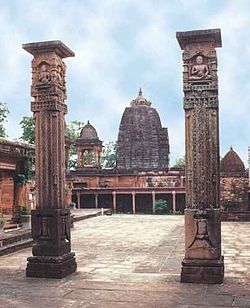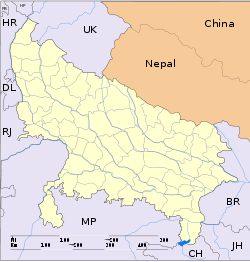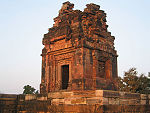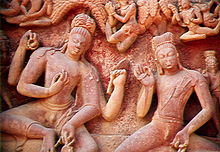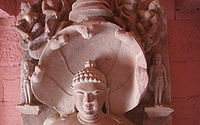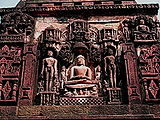- Deogarh, Uttar Pradesh
-
For other uses, see Deogarh.
Deogarh — village — The Shantinath Temple columns in the fort show Jain monks Coordinates 24°31′34″N 78°14′17″E / 24.526°N 78.238°ECoordinates: 24°31′34″N 78°14′17″E / 24.526°N 78.238°E Country India State Uttar Pradesh District(s) Lalitpur district Population
• Density
699 (2001[update])
• 140 /km2 (363 /sq mi)
Time zone IST (UTC+05:30) Area
5 square kilometres (1.9 sq mi)
• 211 metres (692 ft)
Footnotes- Jain and Hindu temples within and outside the fort walls. Jain Mela and Gajrath Mahotsav are the popular festivals held here.
Deogarh (Hindi: देओगढ़) is a small farming village near the town of Lalitpur in Lalitpur district, in the state of Uttar Pradesh, India. Located at the border with the former princely state of Gwalior, which is now part of Madhya Pradesh, it is known for its Gupta monuments, located on and near the hill fort on the right bank of the Betwa River. A number of ancient monuments of Hindu and Jain origins are found within and outside the walls of the fort.[1][2]
The Gupta temple dedicated to Lord Vishnu, popularly known as the Dashavatara Temple, is the earliest known Panchyatana temple in North India. It depicts ten incarnations of Vishnu. Special features of this ancient temple, which is mostly in ruins, include carved figurines of river goddesses Ganga and Yamuna on the doorway to the sanctum sanctorum, three large carved panels of Vaishnava mythology related to Gajendra Moksha, the Nar Narayan Tapasya (meditation), and the Anantshayi Vishnu reclining on a serpent. The fort on the hill is dominated by a cluster of Jain temples on its eastern part, the oldest of these dating to the 8th or 9th century. Apart from Jain temples, the wall frescoes of Jain images of "iconographic and the stylistic variety", are special features of the fort. The three ghats (ghat means "flight of stone steps leading to the river"), which provide approach to the Betwa river edge from the fort — the Nahar Ghat, the Rajghat and the ghat with the Siddiki Ghufa (saints cave) — are also of archeological significance.
The Deogarh monuments are protected by the Department of Archaeology of the Archaeological Survey of India (ASI), and managed through its Northern Circle Office located in Agra. ASI maintain an archaeological museum at the Deogarh site, which is noted for its treasured archaeological sculptures.[3]
Contents
Etymology
"Deogarh" derives from the Sanskrit Deo and garh, "God" and "fort", compounded to mean "fort of the Gods". This term, "House of God", is also widely used as a place name for villages in the vicinity of temples within fort-walls throughout India.[4]
Geography
Further information: Lalitpur district, Uttar PradeshDeogarh village lies on the right bank of the Betwa River, at the point where it joins the reservoir formed by the Rajghat Dam. The village is at the western end of the Lalitpur hill range, situated 23 kilometres (14 mi) south-east from Lalitpur town in Lalitpur district and 123 kilometres (76 mi) south of the divisional administrative centre at Jhansi.[5] The village is spread over an area of 5 square kilometres (1.9 sq mi) with an average elevation of 211 metres (692 ft).[6]
The fort of Deogarh is in a valley which generally has a gentle slope. The valley is formed by the Betwa River at the western end of the hills of the Vindhya Range. Known earlier as Vetravati (Sanskrit, meaning "containing reeds"), the Betwa River is a tributary of the Yamuna River, and skirts the fort hill on its southern side. The river, flowing at a bend near the fort, has a rocky bed. It flows in a cascade of deep pools with steep rocky banks of sandstone formations. The fort is located on a precipice of the steep cliff, just above the river on its right bank.[7]
Demographics
According to the 1991 Census, the population of the Deogarh village was 553. Hindi and Bundeli are the languages spoken in the area.[6] The Census figures of 2001 for the Deogarh village in Birdha block of Lalitpur district (Rural), has recorded a population of 699 covering 125 households. The distribution of male and female population was 375 and 320 respectively. The village had presence of 314 Schedule Caste (SC) population (Male-164 and Female-150). The literacy rate recorded was 43.77% (306 persons out of total of 699).[8]
History
Deogarh's strategic location on the ancient route to the Deccan Plateau made it a historically important place. Its antiquarian, archaeological and epigraphical importance are linked to the Gupta period, the Gurjara–Prathiharas, the Gonds, the Muslim rulers of Delhi, the Marathas and the British eras.[9][10]
The earliest religious influence in the Deogarh area can be traced to the Gupta period (320-550), known as the "golden period" of Indian history. This was followed by the Jain period between the 8th and 17th centuries, where innumerable temples have been traced.[4][10]
The present village's history has not been examined at depth, even though many inscriptions have been located in the fort and the valley, relating to various stylistic and palaeographical denominations. Although the dynasties who ruled over the territory are known, who built what is not clear, except for the Jain temples, which were built by the merchant Jain community. More archaeological explorations would therefore be essential, to establish the linkages of building activities with the dynasties who ruled over the territory, considering the enormous amount of Hindu and Jain temple remains and artifacts found here.[4]
The earliest history of Deogarh is that of the architectural evolution traced to the ancient Gupta period, which flourished between the 4th and 6th centuries in Northern India. During this period, the arts, science and literature saw aesthetic evolution. It was the period when Brahminical, Buddhist and Jain activities flourished.[9][10]
During this time, sculptural arts peaked and "India entered upon the classical phase of sculpture".[12] Even though Guptas were Hindu rulers, the cultures of Buddhism and Jainism also flourished during their reign. During this period, Buddhist sculptures were more puritanical with total elimination of nudity in its depictions. However, transparent tight fitting drapery were dictated by moral values and hence, were restrained. Indian temple architecture emerged with figurine sculptures in decorative settings, attaining excellence of form. This is inferred from the large panel of Sheshashayi Vishnu (Hindu god Vishnu reclining on the serpent Shesha) at the Deogarh temple.[12]
Monuments
The Deogarh monuments can be categorized based on their location at valley and fort temples, which are generally built with sand stones of brick-red colour. The valley temples consist mainly of Hindu temples from the Gupta period near the Deogarh village.
Dashavatara temple

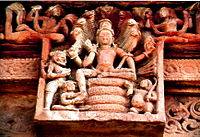 Left: Sheshashayi Vishnu reclining on the serpent-bed of Shesha. Right: Vishnu in sitting posture under the serpent's hood
Left: Sheshashayi Vishnu reclining on the serpent-bed of Shesha. Right: Vishnu in sitting posture under the serpent's hoodThe "Gupta Temple", dedicated to god Vishnu, was first discovered by Captain Charles Strahan. It was given its name by the archaeologist, Cunnigham. Archaeologists have inferred that it is the earliest known Panchayatana temple in North India.[13][14] It was subsequently renamed by Cunningham as Dashavatara Mandir or Dashavatara Temple (because the temple depicts ten incarnations of Vishnu), and also as Sagar Marh (meaning: the temple by the well). It was the first North Indian temple with a shikhara or tower, although the shikhara is curtailed and part of it has disappeared (details as to when the shikara disappeared are not reported). The temple has a high plinth and is set with a basement porch. The Dashavatara temple has a "compelling presence" in spite of its dilapidated condition. Sculpted panels are seen on the terraced basement, with carved figurines of river goddesses Ganga and Yamuna flanking the doorway to the sanctum sanctorum. In addition, on the side walls, three large carved panels of Vaishnava mythology related to Gajendra Moksha, the Nara Narayana Tapasya (meditation), and the Sheshashayi Vishnu (reclining on the serpent), are portrayed. A protective wall made of undressed stone was built around the temple after it was first discovered. However, the idol of the sanctum sanctorum of the temple is missing, believed to have been relocated elsewhere.[6][9][15]
In the unique and large sculpture of Sheshashayi Vishnu, Vishnu is depicted reclining on the serpent Shesha, with four-arms lying down on the spiral of a serpent with seven hoods, forming a shade over his crowned head. Lakshmi (Vishnu's consort), along with her two attendants, are at Vishnu's feet. Other gods and celestials are seen watching this display. In another panel below this, two demons, Madhu and Kaitabha, are getting ready to attack. They are shown to be repulsed by the four personified weapons or ayudhapurushas of Vishnu.[4][16] According to another interpretation, the lower panel depicts the five Pandavas and their common wife Draupadi.
The ancient treatise Vishnudharmottara Purana describes several temples including a "Sarvatobhadra temple", which has been compared by archaeologists and Indologists with the Dashavatara Temple (Vishnu temple) or the Gupta Mandir of Deogarh. A comparative study revealed that the ideal temple design described in the treatise as "Sarvatobhadra temple" was the same as the Vishnu temple of Deogarh. This conclusion was based on plan, size, iconography and several other norms described for building Hindu temples.[17] Based on this comparison, the structural details of the Deogarh temple have been inferred. Maps have also been drawn of the temple structure. The probable date of the temple's construction has been estimated to be between 450 and 650. During this period, the temple was highly venerated.[18] The relief on the doorway (Lalatabhimba in Sanskrit) of the temple depicts Vishnu seated on Shesha the serpent, with Lakshmi sitting down and caressing his feet, flanked by two incarnations of Vishnu: Narasimha (the man-lion form) on the right, and Vamana (the dwarf form) on the left.[19]

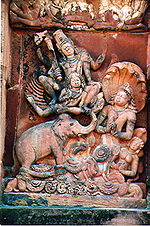 Left: Carved Panel relief on the doorway of Dashavata Temple depicting Lakshmi flanked by Gada and Chakra ayudhapurushas (personified Vishnu's weapons) tending to Vishnu's feet. Right: Carved panel of Gajendra Moksha- Vishnu saves Gajendra, the elephant from clutches of crocodile on one of thw walls of the Vishnu temple
Left: Carved Panel relief on the doorway of Dashavata Temple depicting Lakshmi flanked by Gada and Chakra ayudhapurushas (personified Vishnu's weapons) tending to Vishnu's feet. Right: Carved panel of Gajendra Moksha- Vishnu saves Gajendra, the elephant from clutches of crocodile on one of thw walls of the Vishnu templeThe side and back walls of the temple depict carved panels related to several facets of Lord Vishnu's life. On the northern wall, the elegantly carved panel shows "Gajendra Moksha", which represents Vishnu coming to the rescue of the Gajendra (elephant). On the eastern side wall, a panel depicts a carved image of the sages Nara-Narayana. On the southern wall, Vishnu is depicted reclining on Shesha the serpent, relaxing or in a sleeping or creative mode. These depictions on the four walls (including entrance) of the temple, represent four facets of Vishnu:[19]
the entrance represents Vasudeva; the Gajendramoksha side is referred as Samkarshana, the destructive aspect of Vishnu; the Nara-Narayana side is known as Pradyumna, the preserving aspect of Vishnu; and the Anantashayana side is known as Aniruddha.
The temple faces west, with slight deviation to the south that enables the setting sun's rays to fall on the main idol in the temple. The plinth measures 55.5 feet (16.9 m), about 9 feet (2.7 m) above the bottom step (called the moon stone) of the shrine. In the nine squares layout, the Vishnu temple is in the middle square.[20] Four stairways outside the platform provide access to the temple. However, as per excavation details, combined with the two small shrines with the central shrine seen now, the layout of the temple has been interpreted to represent a typical Panchayatana style of the temples of North India.[14] The total height of the shrine based on isometric projections is about 45 feet (14 m).[21] Provision of porches has not been corroborated but some analogous comparison with the Varaha temple (boar incarnation of Vishnu) in the fort precincts, which belonged to the same period, suggests the existence of porticoes even in the Vishnu temple. Further, a later date Kuriya Bira temple about 2 miles (3.2 km) to the south of the Vishnu temple, has been cited to substantiate that this temple had a mandapa around a small shikara shrine.[22]
The Gupta temple was a "shikara" type of temple, built in a straight edged pyramid shape, but this cannot be fully established by existing evidence. However, the supporting features of copings and amalakas (a bulbous stone finial), support the theory that a shikara existed as part of the main shrine.[23] It was finally concluded that the elegant and auspicious Deogarh temple tallied with the description provided for the Sarvatobhadra temple in the ancient treatise of Vishnudharmottara Purana.[24] The Vishnu temple's uniqueness has been expressed succinctly by archaeologist Percy Brown, in these words:
When complete, this building was unquestionably one of rare merit in the correct ordering of its parts, all alike serving the purpose of practical utility, yet imbued with supreme artistic feeling. Few monuments can show such a high level of workmanship, combined with a ripeness and rich refinement in its sculptural effect as the Gupta temple at Deogarh.[25]
Another unique sculpture found in the Vishnu temple depicts the Krishna legend in which Devaki hands over her new born son Krishna to her husband Vasudeva. This sculpture is said to be one of the best depictions of Gupta period art, based on the sensuous and graceful modelling of the figurines, but different in that its clothes are shown draped in an exclusive fashion. It is now housed at the National Museum in New Delhi.[26]
Fort
The fort on the hill is located a few hundred yards east of Deogarh village. The fort, when originally built, was known as 'Karnali'. Subsequently, it was renamed "Kirtigiridurga" after it was built in 1057 (samvat 1154) during the reign of Chandela King Kirtivarman. However, some believe that fort was built earlier by the Pratihara rulers of Kannauj in the 9th century, changed hands from the builders to the Chandelas and the Bundelas, before it came under the control of the Scindias of Gwalior.[27][28]
The fort has an external wall for the most part, except in stretches where the steep hill slopes towards the Betwa river. It is also subdivided by many internal walls. A circular structure, the west gate and the east gate (south-east of the Jain temples) are notable monuments. Additionally, there are two gates of entry into the fort, the "Hathi Darvaja" meaning "Elephant gate", and "Delhi Darvaja" which means "Delhi gate".[28]
There are three ghats which provide approach to the Betwa river edge, which have archaeological significance. These are the Nahar Ghat, the Rajghat and the Ghat, with the Siddi ki Ghufa (Saints cave).[29]
The Nahar Ghat ("nahar" means boat) at the east end of the fort, has steep steps that go down from the plateau of the fort to the Betwa river. The ghat is aligned parallel to the wall of the cliff and the river. The "Siddhi ki Ghufa" (Cave of the Saint), is an archaeological find, located on the cliff wall to the left, along the descent from the Nehar Ghat. While descending via the Rajghat, the cliff wall is to the right. It is a plain cave. The cave depicts, on its right, an image of the goddess Mahishasuramardini.[29]
The cliffs above the three ghats are embellished with Gupta sculptures and inscriptions dating from various periods. The Nahar Ghat has about a dozen niches, which house lingas and various deities. From an archaeological perspective, this ghat is considered the richest of the three flights of steps. The Rajghat (Kings steps) also accommodate more than a dozen niches with lingas and statues, but the sculptures are small and in an unfinished state.[29]
Matrika statues (seated) are also important archaeological finds at the Nehar Ghat and Rajghat sections, as they establish early sculptural activity in the 6th century. Both these matrika panels are flanked by images of Vinadhara Shiva (Shiva as "bearer of the vina") and his son Ganesha, though with differences in detailing. The sculpted figurines show large breasts, tiny waists and broad hips.[30]
The Varaha temple is also situated in the southeast corner of the fort. But it is in ruins except for a few architectural fragments.
Jain temples
The fort temples are dominated by the Jain temples in the eastern part of the hill fort; the jaina images here are mostly of the "iconographic and the stylistic variety".[4] The Jain temples have a large number of panels depicting scenes from Jain mythology, Tirthankara images and votive tablets. The pillars are carved with a thousand Jain figures.[5]
According to a survey conducted by the Archaeological Survey of India (ASI), 31 Jain temples of different sizes, age and character have been deciphered. All these are dated later than the Hindu temples. They are categorized into two distinct periods: the early medieval period from 850 to 950, and the medieval period between 950 and 1150. During the Islamic iconoclastic depredations, the temples were devastated; this was compounded by the growth of vegetation and neglect of maintenance.
The Jain temples have also been examined individually and reports prepared by ASI. The number of images and inscriptions for each temple have been recorded. These findings testify their political history and early medieval status.[31] Out of the many sculptures in the Jaina compound, at least 400 carvings were worthy of recording for their "stylistic and iconographic variety".[4]
The extravagance of the intricacies of the Jain sculptures are similar to that of nearby Gwalior in Madhya Pradesh and adjoining areas of Bihar.[32] Jain sculptures lie scattered on both sides of the path from the gate, on the walls of the fort. A notable pillar seen here is called the Manastambha. The complete image of each of the 24 Tirthankaras depicting the emblem of a bird, flower or animal are seen here. Images of Yaksha and Yakshini are also part of such depictions. Thousands of sculptures are seen embedded in the walls surrounding the complex. The large number of idols lying scattered around the fort area is attributed to the fact that this was the sculptors' workshop.[9]
Worship at some of the Jain temples are still held regularly. The most famous of the Jain temples in the fort is the Shantinath temple, which was built before 862 AD. It is testament that a prosperous Jain community lived in this region. In 1959, robbers looted a number of Jain images or even cut off heads of many images. This resulted in the Jain community of the area taking precautionary action by setting up a temple committee. This temple committee oversees the protection of the monuments and work to improve the ambience of the entire place. It has been suggested however, that restoration works be carried out on more scientific terms, following guidelines set by "UNESCO's World Heritage Sites".[33]
Within a 50 miles (80 km) radius from Deogarh, the Parwar community of Jains have lived in 1,438 towns and villages (as per 1924 records); the largest number of them living in Lalitpur.
See also
Gallery
-
Images of river goddesses Ganga and Yamuna depicted at the entrance to the Dashavatara temple
-
Image of Nāga King in Dashavatara temple
Notes
- ^ Titze, Kurt; Klaus Bruhn (1998). Jainism: a Pictorial guide to the religion of non-violence. Motilal Banarsidass Publ.. pp. 102–106. ISBN 8120815343. http://books.google.com/books?id=loQkEIf8z5wC&pg=PA105&dq=Deogarh+Uttar+Pradesh&lr=#v=onepage&q=Deogarh%20Uttar%20Pradesh&f=false. Retrieved 2010-01-03.
- ^ Universiteit van Amsterdam and Institute of South Asian Archaeology (1958). Studies in south Asian culture, Part 3. Brill Archive. pp. 1–29. http://books.google.co.in/books?id=2K83AAAAIAAJ&pg=PR15&lpg=PR15&dq=ASI+-Archaeological+Museum+at+Deogarh&source=bl&ots=PqH9ljJPmF&sig=zNROcxhv65SR9TqAqBuOneru-kQ&hl=en&ei=EgBDS9mqMNKHkAWl4_mXBg&sa=X&oi=book_result&ct=result&resnum=7&ved=0CB0Q6AEwBjgU#v=onepage&q=ASI%20-Archeological%20Museum%20at%20Deogarh&f=false.
- ^ Studies in south Asian culture, p.7
- ^ a b c d e f Titze p.103
- ^ a b "Deogarh". http://www.whereincity.com/india/uttar-pradesh/deogarh.php. Retrieved 2010-01-08.
- ^ a b c "Deogarh". Uttra Pradesh Tourism, Government of Uttar Pradesh. http://www.up-tourism.com/destination/deogarh/intro.htm. Retrieved 2010-03-21.
- ^ Titze pp.102–103
- ^ "Lalitpur district 2001. (Rural)". National Informatics Centre. http://lalitpur.nic.in/census2001/rural.htm. Retrieved 2010-03-24.
- ^ a b c d "Fortress of the gods". The Hindu. 2003-08-24. http://www.hinduonnet.com/mag/2003/08/24/stories/2003082400380800.htm. Retrieved 2010-01-05.
- ^ a b c Studies in south Asian culture, pp.31, 62-69
- ^ "Hindu Art;Vishnu". Encyclopædia Britannica. http://www.britannica.com/EBchecked/topic-art/620898/123920/The-Hindu-deity-Vishnu-reclining-on-the-serpent-Sesha-sandstone. Retrieved 2010-03-25.
- ^ a b "Gupta sculpture". Government of India. http://ccrtindia.gov.in/guptasculp.html. Retrieved 2010-01-04.
- ^ "Incredible Uttar Pradesh :: All Places Of Uttar Pradesh Tourism". Deograh. http://www.imagine18.com/incredible-uttar-pradesh-all-places-of-uttar-pradesh-tourism/. Retrieved 2010-01-07.[dead link]
- ^ a b Lubotsky, Alexander. Isomorphic Reconstruction Map of Sarvodhbhadra temple or the Vishnu temple of Deogarh. pp. 9–10. https://openaccess.leidenuniv.nl/bitstream/1887/2668/1/299_022.pdf.
- ^ Studies in south Asian culture, p.29
- ^ "Ancient Indian Treasures Exhibition". Government of India. http://74.125.153.132/search?q=cache:rci9lKxlMEMJ:www.haww.gov.cn/html/20070207/715802.html+Archeological+Museum+at+Deogarh&cd=45&hl=en&ct=clnk&gl=in. Retrieved 2010-01-05.
- ^ Lubotsky pp. 2–3
- ^ Lubotsky p.4
- ^ a b Lubotsky p.5
- ^ Lubotsky p.7
- ^ Lubotsky p.11
- ^ Lubotsky p.13
- ^ Lubotsky p.15
- ^ Lubotsky p.16
- ^ Lubotsky p.17
- ^ Solis, Benjamín Preciado- (1984). The Krishna cycle in the puranaas: themes and motifs in a heroic saga. Motilal Banarsidass. p. 106. ISBN 0895812266. http://books.google.co.in/books?id=JvCaWvjGDVEC&pg=PA106&dq=J.+C.+Harle+Gupta+Sculpture+Deogarh&ei=-GdES9iKMqWSkATHtsHJBw&cd=3#v=onepage&q=J.%20C.%20Harle%20Gupta%20Sculpture%20Deogarh&f=false. Retrieved 2010-01-06.
- ^ "Deogarh in UP is an abode of gods". The Economic Times. 2008-08-28. http://economictimes.indiatimes.com/Features/ET_Travel/Deogarh_in_UP_is_an_abode_of_gods/rssarticleshow/3414110.cms. Retrieved 2010-01-08.
- ^ a b Studies in south Asian culture, p.28
- ^ a b c Studies in south Asian culture, pp.28-29
- ^ Schastok, Sara.L. (1985). The Śāmalājī sculptures and 6th century art in Western India. Brill. pp. 70–71. ISBN 9004069410. http://books.google.co.in/books?id=jh1fF8HvJmMC&pg=PA70&dq=Deogarh&cd=2#v=onepage&q=Deogarh&f=false. Retrieved 2010-01-07.
- ^ Studies in south Asian culture, p.32
- ^ Titze p.105
- ^ Titze p.105-106
References
- Lubotsky, Alexander (pdf). Isomorphic Reconstruction Map of Sarvodhbhadra temple or the Vishnu temple of Deogarh. https://openaccess.leidenuniv.nl/bitstream/1887/2668/1/299_022.pdf.
- Schastok, Sara.L. (1985). The Śāmalājī sculptures and 6th century art in Western India. Brill. pp. 70–71. ISBN 9004069410. http://books.google.co.in/books?id=jh1fF8HvJmMC&pg=PA70&dq=Deogarh&cd=2#v=onepage&q=Deogarh&f=false. Retrieved 2010-01-07.
- Solis, Benjamín Preciado- (1984). The Krishna cycle in the puranaas: themes and motifs in a heroic saga. Motilal Banarsidass. p. 106. ISBN 0895812266. http://books.google.co.in/books?id=JvCaWvjGDVEC&pg=PA106&dq=J.+C.+Harle+Gupta+Sculpture+Deogarh&ei=-GdES9iKMqWSkATHtsHJBw&cd=3#v=onepage&q=J.%20C.%20Harle%20Gupta%20Sculpture%20Deogarh&f=false. Retrieved 2010-01-06.
- Universiteit van Amsterdam and Institute of South Asian Archaeology (1958). Studies in south Asian culture, Part 3. Brill Archive. pp. 1–29. http://books.google.co.in/books?id=2K83AAAAIAAJ&pg=PR15&lpg=PR15&dq=ASI+-Archaeological+Museum+at+Deogarh&source=bl&ots=PqH9ljJPmF&sig=zNROcxhv65SR9TqAqBuOneru-kQ&hl=en&ei=EgBDS9mqMNKHkAWl4_mXBg&sa=X&oi=book_result&ct=result&resnum=7&ved=0CB0Q6AEwBjgU#v=onepage&q=ASI%20-Archeological%20Museum%20at%20Deogarh&f=false.</ref>
- Titze, Kurt; Klaus Bruhn (1998). Jainism: a Pictorial guide to the religion of non-violence. Motilal Banarsidass Publ.. pp. 102–106. ISBN 8120815343. http://books.google.com/books?id=loQkEIf8z5wC&pg=PA105&dq=Deogarh+Uttar+Pradesh&lr=#v=onepage&q=Deogarh%20Uttar%20Pradesh&f=false.
External links
Categories:- Bundelkhand
- Villages in Lalitpur district
Wikimedia Foundation. 2010.

